Image Source: Google.
Google, free host of this Blogger blog, has always had wild things going on behind its friendly search engine face. Follow Google's history carefully, and you learn how a search engine, gathering the behavioral data generated by its users, can be the key to a whole information-driven reality. You also learn how technological developments layer one upon another, with each new functionality enabling the next. And therefore, as Bill Gates has said: "People tend to overestimate what can happen in the next year but underestimate what can happen in the next five." That is why, when Google buys a company or develops a new capability, we should ask: where is Google going?
The company's informal motto is: "Don't be evil." Wiki:
Gen Xer Astro Teller, Google’s Director of New Products, declares that we must override our linear expectations when we try to understand technology's potential:Paul Buchheit ... the creator of Gmail, said he "wanted something that, once you put it in there, would be hard to take out", adding that the slogan was "also a bit of a jab at a lot of the other companies, especially our competitors, who at the time, in our opinion, were kind of exploiting the users to some extent."
"If something rides the rails of exponentially improving computer and data capability, and if its benefits are sufficiently powerful, it is likely to happen – whether we can imagine it today or not."In other words, something Google may do that seems innocuous or incongruous compared to its latest mainstream developments (like its contact lens glucose monitor) can turn out to be essential to tomorrow's integrated technologies. Lately, Google's trail of breadcrumbs leads into a dark forest. From driverless cars, to offshore barges - to Google's immortality app, Calico; from poaching academia's brightest minds to Google Glass; from setting up an e-money system on the back of Google Glass, to crowd-sourcing medicine - to buying killer robots? (Hat tip: SCGNews.)
Promo for development of Google's banking capabilities, using Gmail's user base with Google Wallet and Google Glass: "OK, Glass, empty my bank account." Will Google develop its own cryptocurrency? Image Source: Quartz.
Remember Boston Dynamics? Under a DARPA contract, they have made some of the world's most terrifying weaponized robots (at least, among the ones known to the public), modeled after successful predator species: BigDog, WildCat, Cheetah, SandFlea (which can jump over 9 metres in the air) and Atlas (a real Millennial Terminator robot). In December 2013, Google bought Boston Dynamics. According to the CBC, this was the search engine's eighth robotics company purchase in the past six months, and Google's strategy here relates to the exploration of sensor technology:
CBC business commentator Kevin O'Leary, chair of O'Leary Funds, said Monday that the strategy makes sense, given the majority of "smart and new money going to startups today" is targeting sensor technology. "These robots are basically a bundle of sensors," he added. "What Google is doing here is simply buying a company that's extremely advanced at writing software to interface with sensors."
The Guardian reported that Google plans to introduce robotics capabilities in the next five years, at the urging of Andy Rubin:
Boston Dynamics is not the only robotics company Google has bought in recent years. Put under the leadership of Andy Rubin, previously Google's head of Android, the search company has quietly acquired seven different technology companies to foster a self-described “moonshot” robotics vision.
The acquired companies included Schaft, a small Japanese humanoid robotics company; Meka and Redwood Robotics, San Francisco-based creators of humanoid robots and robot arms; Bot & Dolly who created the robotic camera systems recently used in the movie Gravity; Autofuss an advertising and design company; Holomni, high-tech wheel designer, and Industrial Perception, a startup developing computer vision systems for manufacturing and delivery processes.
Sources told the New York Times that Google’s initial plans are not consumer-focused, instead aimed at manufacturing and industry automation, although products are expected within the next three to five years.
Rubin, before making Android into a mobile powerhouse, started life as a robotics engineer at Zeiss. He has now convinced Google founders Sergey Brin and Larry Page to fund a commercial robotics venture, something Rubin has been mulling for some 10 years.The NYT reports that Google's foray into robotics will initially deal with manufacturing and competing with Amazon in retailing and autodeliveries. But as to any further plans for Google Robotics, the company remains "tight-lipped." The group will initially be based in Palo Alto, California with an office in Japan.
Will Google Robotics have anything to do with a giant, secret "mystery tech campus" currently being built in San Jose, California? At 2 million square feet, the complex will be a game-changer, the "grandddaddy of them all" for over 8,000 employees, owned by an as-yet unrevealed Fortune 500 company.
"Andy Rubin is the engineer heading Google’s robotics effort. He is the man who built the Android software for smartphones." Image Source: NYT.
Boston Dynamics introduced WildCat on Youtube in October 2013. Video Source: Youtube.
Boston Dynamics: Cheetah robot runs over 28 miles per hour. Video Source: Youtube.
Boston Dynamics: Atlas Robot update, October 2013. Video Source: Youtube.
Boston Dynamics SandFlea demo, March 2012. Video Source: Youtube.
Overview of Boston Dynamics' military robots demos, 2013. Video Source: Youtube.




No comments:
Post a Comment